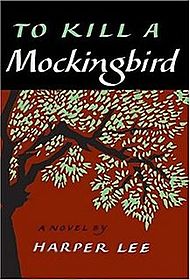We are by this time in class reading the book "to kill a mockingbird" by Harper Lee. As I have mentioned before in my entries, there are two main contexts, and today I am going to show you a few information about Harper Lee's history and experiences.
Nelle Harper Lee was born on April 28, 1926, in Monroeville, Alabama, a sleepy small town similar in many ways to Maycomb, the setting of To Kill a Mockingbird. Like Atticus Finch, the father of Scout, the narrator and protagonist of To Kill a Mockingbird, Lee’s father was a lawyer. Among Lee’s childhood friends was the future novelist and essayist Truman Capote, from whom she drew inspiration for the character Dill. These personal details notwithstanding, Lee maintains that To Kill a Mockingbird was intended to portray not her own childhood home but rather a nonspecific Southern town. “People are people anywhere you put them,” she declared in a 1961 interview.
Yet the book’s setting and characters are not the only aspects of the story shaped by events that occurred during Lee’s childhood. In 1931, when Lee was five, nine young black men were accused of raping two white women near Scottsboro, Alabama. After a series of lengthy, highly publicized, and often bitter trials, five of the nine men were sentenced to long prison terms. Many prominent lawyers and other American citizens saw the sentences as spurious and motivated only by racial prejudice. It was also suspected that the women who had accused the men were lying, and in appeal after appeal, their claims became more dubious. There can be little doubt that the Scottsboro Case, as the trials of the nine men came to be called, served as a seed for the trial that stands at the heart of Lee’s novel.
Lee began To Kill a Mockingbird in the mid-1950s, after moving to New York to become a writer. She completed the novel in 1957 and published it, with revisions, in 1960, just before the peak of the American civil rights movement.
Critical response to To Kill a Mockingbird was mixed: a number of critics found the narrative voice of a nine-year-old girl unconvincing and called the novel overly moralistic. Nevertheless, in the racially charged atmosphere of the early 1960s, the book became an enormous popular success, winning the Pulitzer Prize in 1961 and selling over fifteen million copies. Two years after the book’s publication, an Academy Award–winning film version of the novel, starring Gregory Peck as Atticus Finch, was produced. Meanwhile, the author herself had retreated from the public eye: she avoided interviews, declined to write the screenplay for the film version, and published only a few short pieces after 1961. To Kill a Mockingbird remains her sole published novel. Lee eventually returned to Monroeville and continues to live there.
 As we can see here, a lot of things presented in her nobel are based on what he lived. Other things that involved her childhood were the economic crisis, called the great depression, that affected almost all the United States, having as a resault a lot of poorness and bad life conditions for the ones with no money. She also lived the segregation of african american people. As an example of this: Jim Crow laws; the thaught "separate but equal", between other things involved in racism in US. This are the experiences that helped
As we can see here, a lot of things presented in her nobel are based on what he lived. Other things that involved her childhood were the economic crisis, called the great depression, that affected almost all the United States, having as a resault a lot of poorness and bad life conditions for the ones with no money. She also lived the segregation of african american people. As an example of this: Jim Crow laws; the thaught "separate but equal", between other things involved in racism in US. This are the experiences that helped
H. Lee in the development of the story she called "to kill a mockingbird".
More interesting facts:

No hay comentarios:
Publicar un comentario